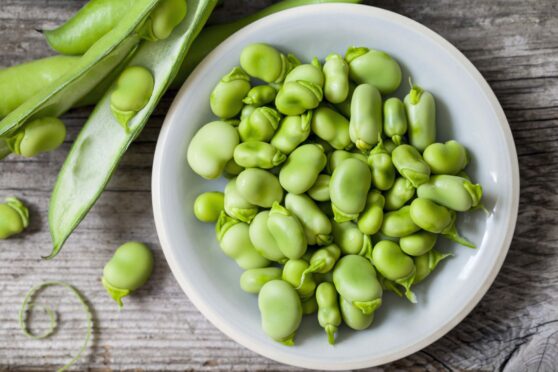
Broad beans, served with melted butter, are one of the best tastes of early summer and now is the time to start sowing them. Pop each bean into a small, deep pot or root trainer and water them, then place in a bright spot under glass and wait for the roots to form.
If you plan to sow your beans directly then wait until next month, when the soil has warmed up a little, and if you have a small garden and plan to grow your broad beans in pots, then choose a dwarf variety. These won’t produce such a high yield, but if you sow in succession then you should be able to crop over a long period.
You can get your beans into the ground earlier if you first cover the soil with thick, dark polythene for a few weeks and then pop a cloche over the rows to provide some extra warmth for germination and to prevent the young seedlings from getting too wet.
Broad beans should be sown on their sides and need protection from mice, which have an insatiable appetite for them.
Tall varieties of broad bean need support, so place a stake at each end of the row and run strings between these at 30cm intervals. Once the first beans start to form, pinch out the top 10cm from each plant for an earlier harvest and also to deter blackfly, which can cause serious problems. Hoe between the rows regularly or apply a thick mulch to prevent weeds from popping up. Other than that, the beans will take care of themselves.
The time to pick your beans is when they begin to show through the pod, but before the scar on the shelled bean has changed colour. This should still be green or white. If you wait until it has turned black then your beans will be tough.
Young pods can be cooked and eaten whole and the upper leaves on each plant can be cooked as spinach.
Once your beans have finished cropping, don’t pull them up. Instead, dig the plants into the soil where they will be a valuable form of green manure.
What’s in bloom?
The spring snowflake (Leucojum vernum) is like a taller version of the snowdrop. It dangles its bell-shaped flowers on 20cm stems, and it is happy in damp soil and around the margins of ponds, where it will develop into large clumps.

Enjoy the convenience of having The Sunday Post delivered as a digital ePaper straight to your smartphone, tablet or computer.
Subscribe for only £5.49 a month and enjoy all the benefits of the printed paper as a digital replica.
Subscribe